![]()
![]()
![]()
Use LEFT and RIGHT arrow keys to navigate between flashcards;
Use UP and DOWN arrow keys to flip the card;
H to show hint;
A reads text to speech;
39 Cards in this Set
- Front
- Back
|
Gastrointestinal Nematodes of Swine |
Hyostrongylus rubidus, Ascarops strongylina, Physocephalus sexalatus, Ascaris suum, Strongyloides ransomi, Trichinella spiralis, Oesophagostomum sp., Trichuris suis |
|
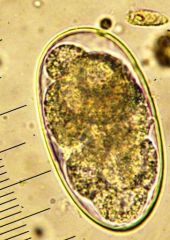
Hyostrongylus rubidus |
Red Stomach Worm Direct Dx: Eggs in feces Infective stage: larvae in soil, vegetation, or on feces |
|
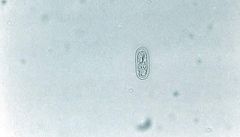
Ascarops strongylina or Physocephalus sexalatus |
Thick Stomach Worm Indirect: host = dung beetle Dx: Eggs in feces Infective stage: larvae in dung beetle |
|

Ascaris suum |
Large round worm Pigs Direct Dx: Sometimes pass worm in feces; 41 cm long, 5cm wide Adults live in small intestine Tx: Ivermectin, Levamisole, Fenbendazole, Pyran Eggs look like tamberine |
|

Strongyloides ransomi |
Threadworms Pig Direct Dx: Eggs or L1 in feces Infective stage: L3 Transferred: ingestion, transmammary, transplacental, penetrate skin Zoonotic When L3 enters the host, it undergoes tracheal migration, lining of intestines; females are parasitic; warm, moist environment; can migrate to fetus and mature to adult after birth Tx: Fenbendazole, Levandazole, Ivermectin |
|
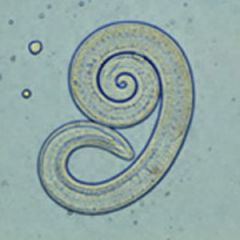
Trichinella spiralis |
Trichina worm Direct host can also be intermediate host Most pigs are asymptomatic; larval stage goes into muscle; ruins meat Zoonotic by undercooked pork |
|

Oesophagostomum sp. (dentatum) |
Nodular Worm Called nodular worm because it penetrates the intestine and causes nodules in the intestinal wall Direct Dx: eggs in feces Infective stage: L3, ingested or penetrate skin Tx: Fenbendazole, Invermectin, Thiabendazole, Iavendazole Looks like Hyostrongylus and Trichostrongylus species
|
|
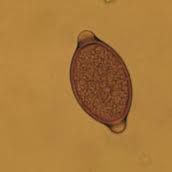
Trichuris suis |
Whipworm Thick, yellow-brown shell with bipolar plugs Live in cecum and colon Live in the ground for 3-5 years Pre. period: 3 months Most dewormers only kill adults; must be treated for a minimum of 3 months |
|
|
Respiratory Nematodes |
Metastrongylus elongatus |
|
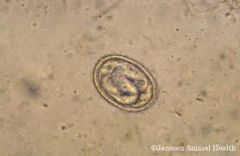
Metastrongylus elongatus |
Lung worm Indirect: host = earthworm Larvae released and migrate to lungs Dx: embrionated eggs in feces and adults in radiograph |
|

Stephanurus dentatus |
Kidney worm (aberrant) 2nd most common in pigs Direct Lives mostly in kidney and in other organs Earthworm may be transport host Dx: eggs in urine Infective stage: L3 - soil or earthworm but skin penetration is possible Dislikes cold climates; If penetrates the skin, it will enter the lungs where it enters systemic circulation and goes to the kidney, but it can be found in the thorax. If ingested, it will pass through the intestinal wall into the hepatic portal system into the liver, where it will stay for 2-9 months, then it will break into the peritoneal region (kidney tissue or fat) in body. 6-16 months before shedding eggs Tx: Ivermectin or Fenbendazole |
|
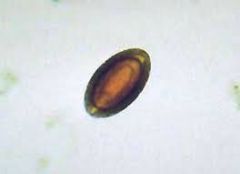
Macracanthorhynchus hirudinaceus |
Thorny-headed worm Indirect: host = dung beetle Adults live in small intestine Dx: eggs in feces Tx: Loperamide, Ivermectin Infective Stage: cystacanth No bi-polar plugs |
|
|
Protozoa of Pigs |
Balantidium coli, Cryptosporidium coli, Cryptoisospora suis or Isospora suis |
|
|
Urogenital Nematodes |
Stephanurus dentatus, Macracanthorhynchus hirudinaceus |
|
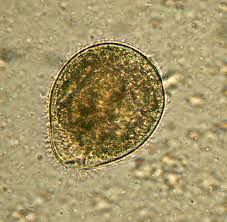
Balantidium coli |
Direct Lives in cecum or colon Dx: oocytes in feces or the motile stage in feces Tx: Metranidazole and also treat symptoms |
|
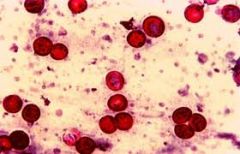
Cryptosporidium coli |
Direct Lives in small intestine Dx: oocytes in feces Zoonotic Tx: Metranidazole and treat symptoms |
|
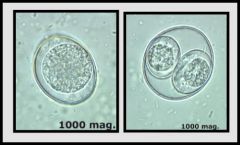
Cystoisospora suis Isospora suis |
Direct Found in small intestine Dx: Oocytes in feces Infective stage: Sporulated Only treat if showing symptoms |
|
|
Blood parasites |
Babesia spp., Mycoplasma haemofelis (Haemobartonella), Mycoplasma haemocanis (Haemobartonella), Eperthyrozoon spp., Anaplasma margonale, Trypanosoma spp. |
|
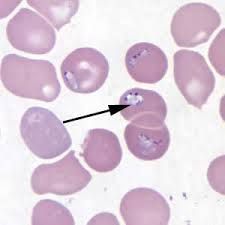
Babesia spp. |
canis = dog, equi = horse, caballi = horse, bigemina = cow Canine & Equine piroplasms Indirect: host = tick Binary fission Dx: Basophilic pear-shaped organism in red blood cell or serum Causes: hemalytic anemia, fever, anorexia Tx: Imidocarb Diproprionate |
|

Mycoplasma spp. |
haemofelis = FIA (Feline Infectious Anemia), haemocanis = very rare Transmitted by fleas and ticks Dx: blood smear Tx: Tetracycline and Oxytetracycline or Doxicycline Causes: Anorexia and Dehydration |
|
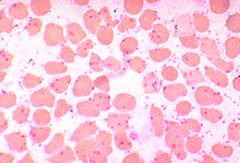
Eperythrozoon spp. |
Definitive Host: cattle, sheep, swine Transmitted by fleas and ticks Dx: Blood smear Tx: Tetracycline and Oxytetracycline or Doxicycline Causes: Anorexia and Dehydration |
|
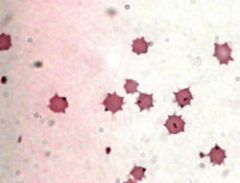
Anaplasma marginale |
Definitive Host: Cattle Transmitted by Ticks Dx: Blood smear or on the serum Tx: Doxicycline Signs: Fever, lethargy, depression, anorexia Zoonotic |
|
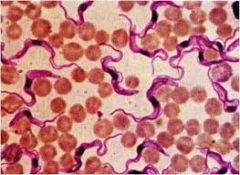
Trypanosoma spp. |
Depends on animal Transmitted by blood-feeding arthropods Dx: Blood smear or histopathology (tissue sample) No known Tx Zoonotic so animals are usually euthanized Cause: Anemia, enlarged spleen, enlarged lymph nodes |
|
|
Arthropods |
Animals with jointed legs; vectors, intermediate hosts, or produce toxins |
|
|
Ticks |
"questing", sense heat and when they feel heat, they attach where the female will engorge on the host, drop to the ground, and lay eggs. The eggs will hatch into larva called seed ticks; larva quest to find small mammal host to feed on; first larva has 6 legs, drops off host, and changes into a nymph which has 8 legs, it climbs onto vegetation, quests, and attaches to another mammal where it gets its meal, drops to the ground, and changes into an adult. The adult finds host, pairs with mate, and the life cycle stats over. Female is bigger than the male. Tx: once a month topicals, sprays, shampoos, tick collars, dips |
|
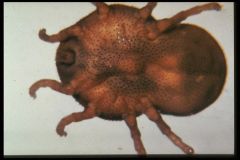
Otobius megnini |
Common Name: Spinous Ear Tick Definitive Host: Dogs, cats, horses Get deep into the ear canal and cause irritation. 1 Host tick; does not drop off to change; stays on one animal. Adults - free living Larval and nymphs - parasitic Adults fall off the animal |
|
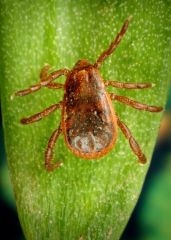
Rhipicephalus sanguineus |
Brown Dog Tick Definitive Host: Dogs, can infest home or kennel Vector of blood parasites: Babesia, Erhlichiosis Can cause tick paralysis - enzyme or toxin in saliva of tick; presents hind limb of animal and can spread to front, leads to death. Tx for ticks: Chemicals, manually, entire head, shave hair of long haired dogs Dx: both blood parasites when seen in blood smear Signs: Pale, weak, fever, enlarged spleen, bleeding disorders Tx for parasites: Antibiotics and Doxicycline |
|
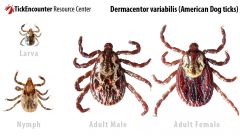
Dermacentor variablis |
American Dog Tick Dogs & Humans Prefers grassy and scrubbrush Vector of: Rocky Mountain Spotted Fever Can cause tick paralysis Signs: Fever, lethargy, enlarged lymph nodes, abdominal pain Dx: Signs and blood tests Tx: antibiotics i.e. Doxicycline |
|
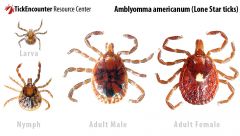
Amblyomma americanum |
Lone Star Tick (because of white spot on apex) Definitive Host: Dogs and humans Found: head, belly, and flank Will feed on humans, painful bite Vector: Rocky Mountain Spotted Fever
|
|
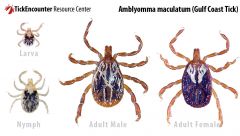
Amblyomma maculatum |
Gulf Coast Tick D. Host: Cattle, horses, sheep, dogs, humans Painful bite, will cause swelling Tick Paralysis can also occur Found on ears in cattle, and will cause ear to droop or deform in horses |
|

Ixodes spp. |
Deer Tick D. Host: Dogs Vector: Lymes Disease Dx: Blood test Tx: Antibiotic i.e. Doxicycline Stress to client the proper removal, landscaping, and proper preventatives |
|
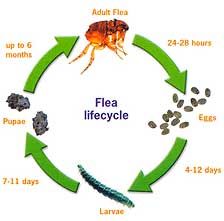
Ctenocephalides felis and canis |
Dog and Cat flea Cat flea is most common Host for tapeworm and haemabartonella Dx: See fleas, flea dirt, flea allergy dermatitis, itching (scratching can cause secondary infection) Fleas transmit to humans Cause: swollen lymph nodes and can lead to death *Flea dirt has digested blood in it |
|

Echidnophaga gallinacea |
Stick-Tight Flea Definitive Host: Chickens, guinea pigs, dogs, and cats Large, can look like tick, female will have the teeth to attach their mouths to a certain spot |
|

Sarcoptes scabei |
Sarcoptic mange D. Host: Dogs Transmitted: direct contact usually between own species but humans can catch, not severe to humans Dx: deep skin scraping "burrowing mite" Mates on top of the skin and lays eggs, eggs hatch into larvae which burrow and tunnel Burrowing and Tunneling cause itching Tx: dip = paramite, use for 2 weeks apart and 2-3 treatments may be necessary, tell clients to soak skin |
|
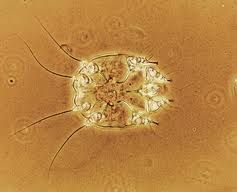
Notoedres cati |
Feline scabes mite Very rare; when have = localized to ears, face, and neck Burrowns and tunnels in epidermis Tx: Ivermectin Keep separated from other cats until a negative skin scrape is obtained |
|
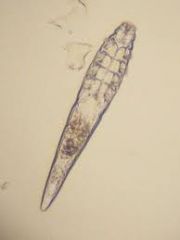
Demodex spp. |
Red mange Found: Sebaceous glands and hair follicles of host Host specific, can be transmitted when puppy is nursing, normal, nonpathogenic but becomes issue if immunodeficiancy or under stress which causes multiplication Tx: Dip: mitaban, every 2 weeks for a minimum of 4 dips, wear goggles and gloves when applying; Dovamectin (Ivermectin derivative) injection = once a week for 6 weeks |
|
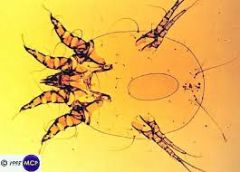
Psoroptes spp. |
cuniculi = rabbit earmite (can be seen on goat, sheep, horse) ovis = sheep scabmite bovis = cow scabmite - affects neck, withers, and rump equi = horse scabmite - affects base of mane and tail All host specific All cause damage to wool; crusty lesions Tx: Ivermectin Highly contagious between animals and must be reported to USDA if seen |
|
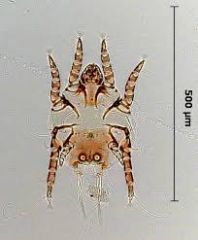
Chorioptes spp. |
Foot and Tail Mite equi = horse, affects pastern and hind leg and spreads to flank and shoulders bovis = cow, affects tail region caprae = goat, affects hind leg ovis = sheep, affects hind leg Tx: Ivermectin |
|

Otodectes cynotis |
Ear Mite D. Host: Dog and cat can swap from dog to cat or cat to dog If animal is part of a multiple animal family, treat everyone Dx: Swab mite and use mineral oil or the Dr. can see with otoscope Tx: Ivermectin, Tresaderm (must be refrigerated and is costly) |

